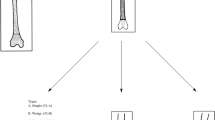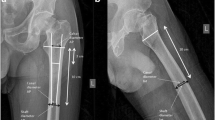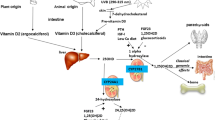Abstract
The purpose of this study was to (1) quantify the healing process of the human osteoporotic proximal humerus fracture (PHF) expressed in terms of callus formation over the fracture region using BMD scanning, and (2) quantify the impact of medical intervention with vitamin D3 and calcium on the healing process of the human osteoporotic fracture. The conservatively treated PHF was chosen in order to follow the genuine fracture healing without influence of osteosynthetic materials or casts. Thirty women (mean age = 78 years; range = 58–88) with a PHF, osteoporosis or osteopenia (based on a hip scan, WHO criteria), and not taking any drugs related to bone formation, including calcium or vitamin D supplementation, were randomly assigned to either oral 800 IU vitamin D3 plus 1 g calcium or placebo, in a double-blind prospective study. We measured biochemical, radiographic, and bone mineral density effect parameters to evaluate the impact on the healing process. Scanning procedures of the fractured shoulder included use of a fixation device to obtain the highest possible precision. Double scans of the fractured shoulder revealed a coefficient of variation (CV) on BMD measurements that improved from 2.8% immediately after fracture occurrence to 1.7% at 12 weeks (P = 0.003) approaching the 1.2% levels observed over the healthy shoulder. BMD was similar in the two groups at baseline (active 0.534 g/cm2 vs. placebo 0.518 g/cm2), and both increased over the 12-week observation period, with peak levels in week 6. By week 6 BMD levels were higher in the active group (0.623 g/cm2) compared with the placebo group (0.570 g/cm2, P = 0.006). Thirty seven percent of the patients presented with vitamin D levels below 30 nmol/l, indicative of mild vitamin D insufficiency. In conclusion, we have demonstrated that it is possible to quantify callus formation of the PHF with sufficiently high precision to demonstrate the positive influence of vitamin D3 and calcium over the first 6 weeks after fracture. Whether this results in more stable fractures, extends to other fracture types, or applies to other osteogenic bone agents such as bisphosphonates remains to be examined.



Similar content being viewed by others
References
Chapman, MW, Closed treatment of fractures and dislocations, In: Chapman’s Orthopaedic Surgery 3rd edition, (2001) Ed: Chapman, MW, Lippincott Williams and Wilkins, Philadelphia: pp 228–229
Mckibbin, B., Repair of fractures, In: Watson-Jones Fractures and Joint Injuries, (1982), Ed: J.N. Wilson, Churchill Livingstone, Edinburgh. pp 14–28
AM Doetsch J Faber N Lynnerup I Wätjen H Bliddal B Danneskiold–Samsøe (2002) ArticleTitleBone mineral density measurement over the shoulder region Calcif Tissue Int 71 308–314
H Omeroglu Y Ates O Akkus F Korkusuz A Bicimoglu N Akkas (1997) ArticleTitleBiomechanical analysis of the effects of single high-dose vitamin D3 on fracture healing in a healthy rabbit model Arch Orthop Trauma Surg 116 271–274
AD Delgado–Martinez ME Martinez MT Carrascal M Rodriguez–Avial L Munuera (1998) ArticleTitleEffect of 25-OH-vitamin D on fracture healing in elderly rats J Orthop Res 16 650–653
PF Brumbaugh DP Speer MJ Pitt (1982) ArticleTitle1 alpha, 25-Dihydroxyvitamin D3 a metabolite of vitamin D that promotes bone repair Am J Pathol 106 171–179
Chapman, MW, Closed treatment of fractures and dislocations, In: Chapman’s Orthopaedic Surgery, 3rd edition, (2001) Ed: Chapman, MW, Lippincott Williams and Wilkins, Philadelphia: pp 230
Chapman, MW, Osteoporosis, In: Chapman’s Orthopaedic Surgery 3rd edition, (2001) Ed: Chapman, MW, Lippincott Williams and Wilkins, Philadelphia: pp 3497
DR Steinberg RM Szabo (1995) ArticleTitleDecision making in upper extremity problems in the elderly Clin Orthop Jul . 63–69
2nd Neer CS (1970) ArticleTitleDisplaced proximal humeral fractures. I. Classification and evaluation J Bone Joint Surg Am 52 1077–1089
JA Kanis (1994) ArticleTitleAssessment of fracture risk and its application to screening for postmenopausal osteoporosis: synopsis of a WHO report. WHO Study Group Osteoporos Int 4 368–381
JM Bland DG Altman (1986) ArticleTitleStatistical methods for assessing agreement between two methods of clinical measurement Lancet 1 307–310
Norland XR-36 Dexa Scanner Manuel, Norland, Inc, Fort Atkinson WI., (1993)
RP Wielen Particlevan der MR Lowik H Berg Particlevan den LC Groot Particlede J Haller O Moreiras WA Staveren Particlevan (1995) ArticleTitleSerum vitamin D concentrations among elderly people in Europe Lancet 346 207–210
Chapman, MW, Closed treatment of fractures and dislocations, In: Chapman’s Orthopaedic Surgery 3rd edition, (2001) Ed: Chapman, MW, Lippincott Williams and Wilkins, Philadelphia: pp 226, 229
D Paley MA Catagni F Argnani A Villa GB Benedetti R Cattaneo (1989) ArticleTitleIlizarov treatment of tibial nonunions with bone loss Clin Orthop Apr . 146–165
HM Frost (1989) ArticleTitleThe biology of fracture healing. An overview for clinicians Part I. Clin Orthop Nov . 283–293
CI Moorcroft PJ Ogrodnik PB Thomas RH Wade (2001) ArticleTitleMechanical properties of callus in human tibial fractures: a preliminary investigation Clin Biomech 16 776–782
K Choi SA Goldstein (1992) ArticleTitleA comparison of the fatigue behavior of human trabecular and cortical bone tissue J Biomech 25 1371–1381
SA Goldstein R Goulet D McCubbrey (1993) ArticleTitleMeasurement and significance of three-dimensional architecture to the mechanical integrity of trabecular bone Calcif Tissue Int 53 IssueIDSuppl 1 S127–132
SG Roberts CR Steele (2000) ArticleTitleEfficacy of monitoring long-bone fracture healing by measurement of either bone stiffness or resonant frequency: numerical simulation J Orthop Res 18 691–697
Acknowledgments
Thanks to laboratory technicians Tove Riis, Sala Hirschorn, Jette Nielsen, and secretary Helle Brandrup. Vitamin D measurements were generously provided by Peter Schwartz, M.D., Department of Biochemistry, Hvidovre University Hospital, Denmark. Statistician Lene Theil Skovgaard, Biostat, The Panum Institute, University of Copenhagen is acknowledged for her statistical contribution. The study was supported by grants from The Danish Medical Research Council, Green Flash ApS., A.V. Lykfeldt og Hustrus Legat, Nycomed A/S, and The OAK Foundation.
Author information
Authors and Affiliations
Corresponding author
Rights and permissions
About this article
Cite this article
Doetsch, A.M., Faber, J., Lynnerup, N. et al. The Effect of Calcium and Vitamin D3 Supplementation on the Healing of the Proximal Humerus Fracture: A Randomized Placebo-Controlled Study. Calcif Tissue Int 75, 183–188 (2004). https://doi.org/10.1007/s00223-004-0167-0
Received:
Accepted:
Published:
Issue Date:
DOI: https://doi.org/10.1007/s00223-004-0167-0




